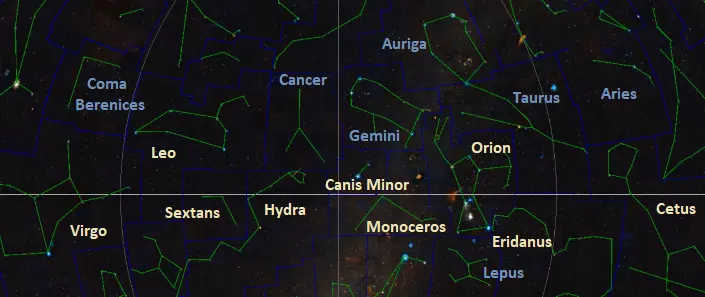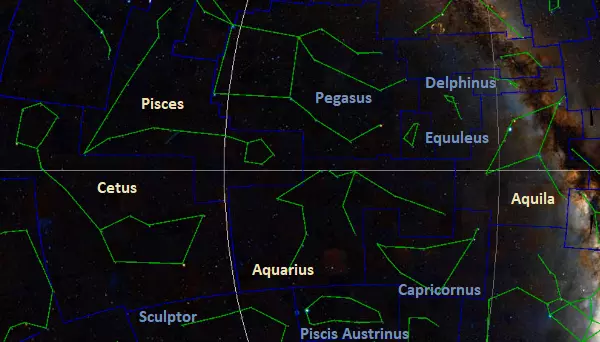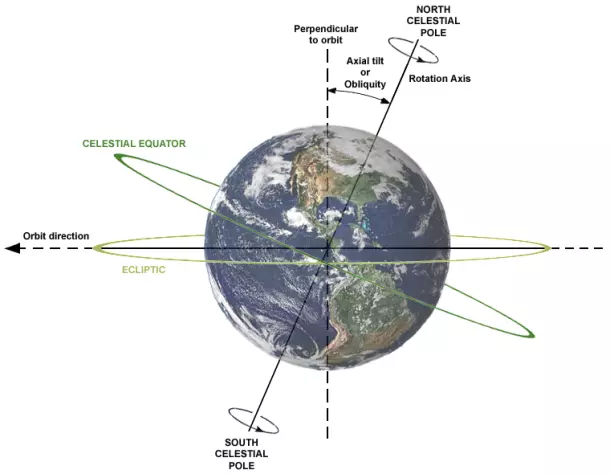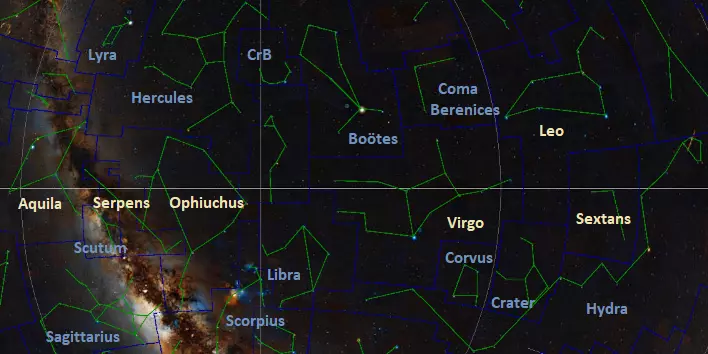Equatorial constellations are the 15 constellations that intersect the celestial equator. These constellations are visible from most places on Earth but are not circumpolar (visible throughout the year) from any location. They lie south of the northern circumpolar constellations and north of the southern ones.
The 15 equatorial constellations are:
- Aquarius
- Aquila
- Canis Minor
- Cetus
- Eridanus
- Hydra
- Leo
- Monoceros
- Ophiuchus
- Orion
- Pisces
- Serpens
- Sextans
- Taurus
- Virgo

Equatorial constellations Virgo, Leo, Sextans, Hydra, Canis Minor, Monoceros, Orion, Eridanus, and Cetus, image: Wikisky
Equatorial constellations are among the most universally recognizable constellations in the sky. Visible from virtually anywhere for at least a part of the year, they culminate highest when seen from locations near the equator.
Mintaka, the westernmost (right) star of Orion’s Belt, is the nearest bright star to the celestial equator. It is located only a quarter of a degree south of the line dividing the northern and southern celestial hemispheres. Observers near the equator can use it to find east and west at night, since the star rises almost exactly in the east and sets in the west.

Equatorial constellations Cetus, Pisces, Aquarius, and Aquila, image: Wikisky
Even though there are several zodiac constellations in this group, equatorial constellations are not to be confused with constellations intersected by the ecliptic. The celestial equator is a projection of the Earth’s equator into space, while the ecliptic is the Earth’s orbital plane. In other words, the ecliptic is the Sun’s apparent path across the sky from the perspective of an observer on Earth. Due to our planet’s axial tilt (the angle between its equatorial plane and orbital plane), the celestial equator is currently tilted by 23.44 degrees with respect to the ecliptic. While the two intersect, they are not coplanar, which means that ecliptic constellations (the 12 zodiac constellations and Ophiuchus) and constellations on the celestial equator are two separate groups.

Celestial equator and the ecliptic, image: Dennis Nilsson (CC BY 3.0)
The two points where the ecliptic and the celestial equator intersect are known as the equinoxes. These are the points at which the Sun appears directly above the equator twice a year, marking a change of seasons. The vernal (spring) equinox varies between March 19 and 21 and marks the first day of astronomical spring, while the autumnal equinox marks the first day of autumn, which falls between September 21 and 24.
The vernal and autumnal equinoxes were known as the First Point of Aries and First Point of Libra when Hipparchus defined them in 130 BCE. They have shifted westwards by about 30 degrees since Hipparchus’ time and today they lie in the constellations Pisces and Virgo. Aries and Libra do not lie on the celestial equator anymore; Libra has shifted to the south and Aries to the north. The autumnal equinox will shift into Leo around the year 2440, while the spring equinox is gradually moving toward Aquarius.

Equatorial constellations Aquila, Serpens, Ophiuchus, Virgo, Leo, and Sextans, image: Wikisky
Due to Earth’s axial precession (gradual change in the orientation of its rotational axis), the constellations through which the celestial equator passes will also change over time.
There are currently six constellations intersected by both the equator and the ecliptic: Aquarius, Leo, Ophiuchus, Pisces, Taurus, and Virgo. Taurus is also intersected by the galactic plane of the Milky Way.
The table below shows the latitudes the equatorial constellations are visible from and the time of year when they appear highest in the evening sky.
| Constellation | Visible between latitudes | Best time to observe | |
| Aquarius | +65° | -90° | October |
| Aquila | +90° | -75° | August |
| Canis Minor | +90° | -75° | March |
| Cetus | +70° | -90° | November |
| Eridanus | +32° | -90° | December |
| Hydra | +54° | -83° | April |
| Leo | +90° | -65° | April |
| Monoceros | +75° | -90° | February |
| Ophiuchus | +80° | -80° | July |
| Orion | +85° | -75° | January |
| Pisces | +90° | -65° | November |
| Serpens | +80° | -80° | July |
| Sextans | +80° | -90° | April |
| Taurus | +90° | -65° | January |
| Virgo | +80° | -80° | May |